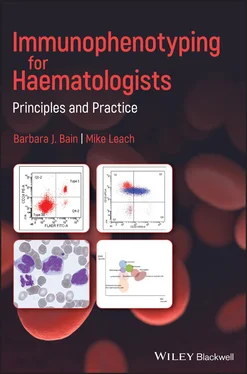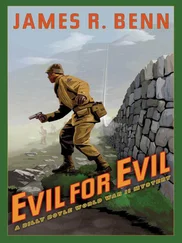1 Cover
2 Title Page Immunophenotyping for Haematologists Principles and Practice Barbara J. Bain, MB BS, FRACP, FRCPath Professor of Diagnostic Haematology St Mary’s Hospital Campus, Imperial College London and Honorary Consultant Haematologist St Mary’s Hospital, London, UK Mike Leach, MB ChB, FRCP, FRCPath Consultant Haematologist and Honorary Senior Lecturer Haematology Laboratories and West of Scotland Cancer Centre Gartnavel General Hospital, Glasgow, UK
3 Copyright Page
4 Preface
5 Acknowledgement
6 Abbreviations Used in the Book
7 Part 1: Purpose and Principles of Immunophenotyping Flow Cytometric Immunophenotyping Immunohistochemistry Interpretation and Limitations of Flow Cytometric Immunophenotyping Problems and Pitfalls References Bibliography
8 Part 2: Immunophenotyping for Haematologists A Compendium of Antibodies and Patterns of Expression of Equivalent Antigens in Normal and Neoplastic Cells Abbreviations Antibodies with CD numbers Antibodies without CD numbers Bibliography Websites
9 Part 3: Immunophenotyping in the Diagnosis and Monitoring of Haematological Neoplasms and Related Conditions with Tables and Figures for Quick Reference Abbreviations Normal Peripheral Blood and Bone Marrow Cells, Lineage and Stem Cell Markers Acute Myeloid Leukaemia Acute Lymphoblastic Leukaemia, Mixed Phenotype Acute Leukaemia and Undifferentiated Acute Leukaemia Myelodysplastic Syndromes and Myelodysplastic/Myeloproliferative Neoplasms Myeloproliferative Neoplasms Systemic Mastocytosis Blastic Plasmacytoid Dendritic Cell Neoplasm Langerhans Cell Histiocytosis and Erdheim–Chester Disease Histiocytic Sarcoma Mature B‐lineage Neoplasms Plasma Cell Neoplasms Hodgkin Lymphoma Mature T‐lineage and NK‐lineage Neoplasms Minimal Residual Disease Paroxysmal Nocturnal Haemoglobinuria Conclusion References Bibliography Websites
10 Part 4: Test Yourself Abbreviations Short Answer Questions (Single Best Answer) Extended Matching Questions FRCPath‐Type Questions Answers to SAQs Answers to EMQs Answers to FRCPath‐Type Questions References Further Reading
11 Index
12 End User License Agreement
1 Part 1 Table 1.1 Commonly used fluorochromes. Table 1.2 Role of flow cytometric immunophenotyping.
2 Part 3Table 3.1 Lineage and stem cell markers.Table 3.2 Immunophenotyping of acute myeloid leukaemia and blastic plasmacyto...Table 3.3 Immunophenotyping of normal mature T and B cells and in acute lymph...Table 3.4 Maturation stages of B‐lineage acute lymphoblastic leukaemia.Table 3.5 Typical immunophenotypic characteristics of common ALL cells compar...Table 3.6 Maturation stages of T‐lineage acute lymphoblastic leukaemia.Table 3.7 A scoring system for the identification of early T‐cell precursor a...Table 3.8 Markers that are required for the definition of mixed phenotype acu...Table 3.9 Markers that have been applied in the diagnosis of myelodysplastic ...Table 3.10 Characteristic immunophenotype of chronic B‐cell leukaemias and B‐...Table 3.11 A comparison of the typical immunophenotype of normal plasma cells...Table 3.12 A comparison of the typical immunophenotype of neoplastic cells in...Table 3.13 Characteristic immunophenotype of mature T‐cell and NK‐cell neopla...Table 3.14 Antibodies that can be used in panels for monitoring minimal resid...Table 3.15 Markers that can be used in the flow cytometric diagnosis of parox...
1 Part 1 Figure 1.1 Diagrammatic representation of the principles of flow cytometric ... Figure 1.2 Delineation of peripheral blood leucocyte populations using forwa... Figure 1.3 Delineation of peripheral blood or bone marrow leucocyte populati... Figure 1.4 Delineation of peripheral blood or bone marrow B‐cell populations... Figure 1.5 Delineation of peripheral blood or bone marrow CD34+ blast popula...
2 Part 3Figure 3.1 Antigen expression during maturation of the neutrophil lineage wi...Figure 3.2 Antigen expression during maturation of the monocyte lineage in t...Figure 3.3 Antigen expression during maturation of the erythroid lineage in ...Figure 3.4 Antigen expression during maturation of the B‐lymphocyte lineage ...Figure 3.5 Antigen expression during maturation of the T‐lymphocyte lineage ...Figure 3.6 Bone marrow aspirate showing haematogones in a child during follo...Figure 3.7 Flow cytometric immunophenotyping: (a) CD10 versus CD20 plot demo...Figure 3.8 Flow cytometric immunophenotyping showing haematogones: (a) gatin...Figure 3.9 Flow cytometric immunophenotyping showing typical CD10 and CD20 e...Figure 3.10 Flow cytometric immunophenotyping showing reduced granulocyte si...Figure 3.11 Forward scatter (FSC) versus side scatter (SSC) plot from a case...
3 Part 4Figure 4.1 (×100)Figure 4.2a (×50)Figure 4.2b (×50)Figure 4.3a (×50)Figure 4.3b (×50)Figure 4.4a (×50)Figure 4.4b (×50)Figure 4.4c Figure 4.5a (×50)Figure 4.5b (×50)Figure 4.5c Figure 4.5d Figure 4.6a (×100)Figure 4.6b (×100)Figure 4.6c Figure 4.6d Figure 4.6e Figure 4.6f Figure 4.7a (×50)Figure 4.7b (×50)Figure 4.8a (×100)Figure 4.8b (×100)Figure 4.9a (×100)Figure 4.9b (×100)Figure 4.9c Figure 4.9d Figure 4.9e Figure 4.10a (×100)Figure 4.10b (×100)Figure 4.10c Figure 4.11 (×50)Figure 4.12 (×50)Figure 4.13a (×100)Figure 4.13b (×100)Figure 4.13c Figure 4.13d Figure 4.14a (×50)Figure 4.14b (×100)Figure 4.14c Figure 4.15a (×100)Figure 4.15b (×100)Figure 4.16a (×50)Figure 4.16b (×50)Figure 4.16c (×50)Figure 4.16d Figure 4.16e Figure 4.16f Figure 4.17a Monoblast (×100).Figure 4.17b Promonocyte (×100).Figure 4.17c Immature monocyte (×100).Figure 4.17d Mature monocyte (×100).Figure 4.18a Figure 4.18b Figure 4.19a Figure 4.19b Figure 4.20 Figure 4.21a Figure 4.21b
1 Cover
2 Table of Contents
3 Begin Reading
1 iii
2 iv
3 vii
4 ix
5 x
6 1
7 2
8 3
9 4
10 5
11 6
12 7
13 8
14 9
15 11
16 12
17 13
18 14
19 15
20 16
21 17
22 18
23 19
24 20
25 21
26 22
27 23
28 24
29 25
30 26
31 27
32 28
33 29
34 30
35 31
36 32
37 33
38 34
39 35
40 36
41 37
42 38
43 39
44 40
45 41
46 42
47 43
48 44
49 45
50 46
51 47
52 48
53 49
54 50
55 51
56 52
57 53
58 54
59 55
60 56
61 57
62 58
63 59
64 60
65 61
66 62
67 63
68 64
69 65
70 66
71 67
72 68
73 69
74 70
75 71
76 72
77 73
78 74
79 75
80 76
81 77
82 78
83 79
84 80
85 81
86 82
87 83
88 84
89 85
90 86
91 87
92 89
93 90
94 91
95 92
96 93
97 94
98 95
99 96
100 97
101 98
102 99
103 100
104 101
105 102
106 103
107 104
108 105
109 106
110 107
111 108
112 109
113 110
114 111
115 112
116 113
117 114
118 115
119 116
120 117
121 118
122 119
123 120
124 121
125 122
126 123
127 124
128 125
129 127
130 128
131 129
132 130
133 131
134 132
135 133
136 134
137 135
Immunophenotyping for Haematologists
Principles and Practice
Barbara J. Bain, MB BS, FRACP, FRCPath
Professor of Diagnostic Haematology
Читать дальше












